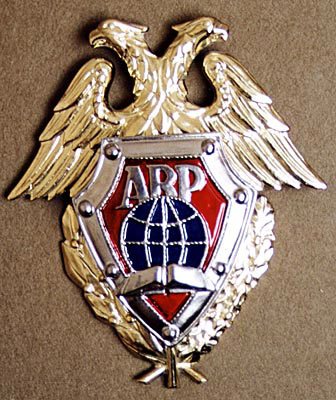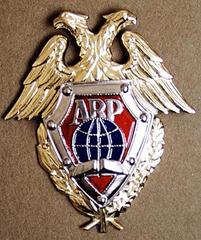
Academy of Foreign Intelligence Moscow: Visiting Hours, Tickets, and Historical Significance Guide
Date: 14/06/2025
Introduction
The Academy of Foreign Intelligence in Moscow is one of Russia’s most secretive and historically pivotal institutions, renowned for its vital role in training elite foreign intelligence officers since the Soviet era. Located primarily in the Yasenevo District and at other secure sites on the outskirts of Moscow, the academy—originating as the 101st Intelligence School and later known as the Yuri Andropov Red Banner Institute—now serves as the premier training ground for the Russian Foreign Intelligence Service (SVR). Its curriculum spans foreign languages, political science, cyber operations, and practical espionage, reflecting its enduring importance in shaping Russia’s intelligence capabilities on the global stage.
As a classified government facility, the Academy is entirely closed to the public, with strict security protocols prohibiting visits, photography, or any unauthorized approach. Nevertheless, understanding its history, structure, and cultural significance provides valuable insight into Russia’s intelligence community and the broader heritage of espionage in Moscow. For those interested in espionage history, attractions such as the KGB Museum and Bunker-42 Cold War Museum offer accessible, informative experiences in the city. This guide presents a detailed overview of the Academy’s background, significance, and practical visitor information, equipping readers with essential knowledge and travel tips for exploring Moscow’s intelligence-related sites safely and respectfully (Espionage History Archive, Wikipedia, Express to Russia).
Table of Contents
- Introduction
- Location and Campus Overview
- Security and Access Restrictions
- Historical Evolution and Educational Role
- Training and Support Facilities
- Legal and Security Considerations
- Alternative Espionage Sites in Moscow
- Visitor Essentials: Travel, Language, and Safety Tips
- FAQ
- Summary Table: Key Facts
- Conclusion
- Visuals and Further Resources
Location and Campus Overview
The Academy of Foreign Intelligence is situated in the southwestern Yasenevo District of Moscow, in a heavily wooded and restricted area. The district is also home to the SVR headquarters, underscoring its strategic significance. The precise address is classified for security reasons, but it is widely acknowledged that the campus is surrounded by high fences, dense forests, and multiple layers of surveillance and armed security (Wikipedia). Additional facilities are reportedly located north of Moscow in the Chelebityevo and Yurlovo areas (everything.explained.today).
The Yasenevo District itself is notable for its intelligence institutions as well as its historical architecture and green spaces, making it of interest to those studying the development of Russia’s security services.
Security and Access Restrictions
The Academy is a restricted government site, protected by multiple security measures—including electronic surveillance, checkpoints, and armed guards. Access is strictly limited to authorized personnel, and even Russian citizens require special clearance. Attempts to approach, photograph, or document the facility without authorization are strictly prohibited and can result in questioning, fines, detention, or deportation for foreigners (irp.fas.org).
There are no public visiting hours, tours, or tickets available for the Academy. The facility is not served by public transportation and is inaccessible to tourists.
Historical Evolution and Educational Role
Originally established during the Soviet era as the 101st Intelligence School, the institution evolved into the Red Banner Institute and later the Yuri Andropov Red Banner Institute. Following the dissolution of the Soviet Union, it was restructured as the Academy of Foreign Intelligence under the SVR in 1994, adapting its training programs to the new geopolitical landscape (files.ethz.ch, Espionage History Archive). The Academy has produced many of Russia’s most prominent intelligence officers, including senior KGB and SVR leaders, and continues to be a central institution for Russia’s external intelligence operations.
Training and Support Facilities
Although not open to the public, the Academy’s campus is known to contain:
- Lecture Halls and Classrooms: Equipped for instruction in languages, political science, international relations, and technical disciplines.
- Language Laboratories: Designed for immersive foreign language instruction, a core skill for intelligence officers.
- Cyber and Technical Training Centers: Focused on IT, cybersecurity, and electronic surveillance.
- Simulation Areas: Including mock urban environments and safe houses for practical training (Espionage History Archive).
- Library and Research Centers: Housing extensive collections on espionage and international affairs.
- Recreational Facilities: Gyms, sports fields, and dining halls to support the physical and social needs of trainees.
The culture at the Academy emphasizes discipline, confidentiality, and loyalty, with candidates undergoing polygraph examinations as part of their admissions process (irp.fas.org).
Legal and Security Considerations
The Academy is protected under Russian federal law, with all approaches, photography, or documentation by unauthorized personnel strictly forbidden. Penalties for violating these restrictions can include fines, detention, or deportation. Foreign visitors in Moscow should respect all security signage and avoid discussing intelligence topics or inquiring about sensitive sites with local residents (irp.fas.org).
Alternative Espionage Sites in Moscow
While the Academy itself cannot be visited, Moscow offers several attractions for those interested in intelligence history:
- KGB Museum: Located in central Moscow, this museum features artifacts, exhibits, and guided tours on Soviet-era intelligence (Express to Russia).
- Bunker-42 Cold War Museum: An interactive museum inside a decommissioned military bunker, focusing on Cold War and espionage history with English-language tours (discoveryrussia.com).
- Walking Tours: Themed walks highlighting Soviet intelligence, KGB buildings, and significant espionage sites (travelstride.com).
These alternatives provide immersive and legal ways to engage with Russia’s intelligence heritage.
Visitor Essentials: Travel, Language, and Safety Tips
- Transportation: The Academy is not accessible by public transport. For exploring Moscow’s museums and historical sites, use the city’s metro and official taxis (thatswhatshehad.com).
- Entry Requirements: Foreign visitors require a visa, proof of accommodation, and travel insurance (ivisatravel.com). Registration with the Federal Migration Service within seven days of arrival is mandatory.
- Language: Russian is the official language; English is less common. Learn basic Russian phrases or use translation apps (theinvisibletourist.com).
- Currency: The Russian ruble (RUB) is used throughout Moscow. Credit cards are accepted, but carry some cash for small purchases (ivisatravel.com).
- Safety: Avoid restricted sites, comply with security officials, and never attempt unauthorized photography or access.
FAQ
Q: Can I visit the Academy of Foreign Intelligence?
A: No. It is a classified government facility with no public access or tours.
Q: Are there espionage-related sites open to tourists in Moscow?
A: Yes, such as the KGB Museum and Bunker-42 Cold War Museum.
Q: Is it legal to photograph the Academy or nearby buildings?
A: No. Photography or approaching the Academy is prohibited and may result in legal consequences.
Q: How do I get to the Academy?
A: The Academy is not accessible to visitors and is located outside central Moscow.
Q: What should I do if approached by security personnel?
A: Remain calm, present your documents, and follow all instructions.
Summary Table: Key Facts
| Feature | Details |
|---|---|
| Location | Yasenevo District, Moscow (exact address classified); additional sites north of Moscow |
| Access | Strictly restricted to authorized personnel |
| Campus Facilities | Lecture halls, language labs, cyber centers, simulation areas, sports facilities |
| Security | High fences, armed guards, surveillance, checkpoints |
| Historical Evolution | 101st Intelligence School → Red Banner Institute → Yuri Andropov Institute → Academy of Foreign Intelligence |
| Public Tours | Not available |
| Alternative Attractions | KGB Museum, Bunker-42 Cold War Museum, Espionage-themed walking tours |
Conclusion
The Academy of Foreign Intelligence remains one of Moscow’s most closely guarded institutions, central to Russia’s intelligence history and global espionage operations. While public access is impossible, understanding the Academy’s evolution, training programs, and significance provides valuable context for those interested in intelligence and Cold War history. Visitors are advised to respect all security protocols and focus their exploration on Moscow’s public espionage museums and historical sites for a safe, legal, and enriching experience.
For further details on Moscow’s intelligence landmarks and travel tips, consult official tourism resources and apps like Audiala.
Visuals and Further Resources
- Image 1: Aerial view of Yasenevo District with approximate location of the Academy (alt text: “Aerial view of Yasenevo District, Moscow, showing the location of the Academy of Foreign Intelligence”)
- Image 2: Historic photo of the Academy’s older dormitory buildings (alt text: “Historic dormitory buildings at the Academy of Foreign Intelligence”)
- Interactive Map: Yasenevo District and major espionage-related sites
References and External Links
- Espionage History Archive
- Wikipedia: Foreign Intelligence Service (Russia)
- Express to Russia: Moscow Vacation Guide
- IRP FAS: SVR Overview
- Everything Explained Today: Academy of Foreign Intelligence
- Discovery Russia: Tours to Moscow
- Thats What She Had: Russia Travel Tips
- IVisaTravel: 10 Top Tips for Traveling to Russia
- The Invisible Tourist: Dos and Don’ts in Russia
- Welcome Moscow





















































































































































































































































































